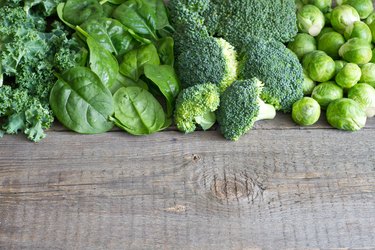
The A1C is a blood test that measures your average blood glucose, or blood sugar, for the past 2 to 3 months. This test is used to diagnose diabetes and prediabetes, and to monitor blood sugars in these conditions.
Diabetes medications, including pills and insulin, are often used to help get the A1c to target — which is below 7 percent for most people with diabetes. However, diet is an important strategy for managing blood sugars, and emphasizing blood sugar-friendly foods within an overall healthy food pattern can also help lower your A1c.
Video of the Day
Video of the Day
Guiding Principles
Foods don't directly reduce blood sugars. Rather, most food makes blood sugars increase. Any decrease in blood sugar tends to be related to the body's own insulin action, from exercise, or due to the effect of diabetes medications.
Consequently, foods or diet patterns that reduce A1c are really those that cause a slow or mild rise in post-meal blood sugars, which helps the body — sometimes with the assistance of medications — achieve near-normal blood sugar readings.
The foods that have the most direct impact on blood sugars are those that contain carbohydrates, so an effective diabetes food plan addresses the type and quantity of carbohydrates in the daily diet.
Vegetables
It's no secret that vegetables are a component of a healthy diet, and this is especially true for people with diabetes. Not only are most vegetables relatively low in carbohydrates, they are also a good source of fiber, rich in nutrients — and their inclusion in the diet can help reduce A1c.
A study of 417 Japanese men linked daily intake of 1 cup of vegetables and 1/2 cup of green vegetables to reduced A1c levels. Vegetables are extremely versatile, and can be easily incorporated into the diet — whether raw, steamed, roasted, grilled, fermented or stewed.
Legumes
Although they are a source of carbohydrates, legumes are also an excellent addition to a diabetes food plan. These high fiber and nutrient-rich foods are associated with a lower-than-expected blood sugar rise after meals.
A randomized, controlled trial demonstrated an average A1c reduction — from 7.4 to 6.9 percent — with the daily addition of 1 cup of cooked beans, chickpeas or lentils.
Legumes are high in fiber and plant protein, which can delay stomach emptying and slow the release of sugar from the gut. These blood sugar-friendly foods also contain resistant starch — meaning some of the carbohydrate resists digestion — which helps explain the blunted blood sugar rise after meals.
High Fiber Foods
High fiber foods, particularly choices high in soluble fiber, are also linked to improved A1c levels. The soluble fiber found in oats, legumes, barley and many fruits and vegetables forms a gel in the gut and slows the release of glucose into the bloodstream.
All fiber-rich foods, including whole grains, nuts, seeds, and whole fruits and vegetables, help with appetite control and may improve blood sugars if they curb overeating.
Also, when a high fiber diet is consumed, the gut environment is actually modified as the intestinal bacteria ferment this fiber. These changes can help the body control blood sugars better, partly due to increased production of glucagon-like-peptide-1, or GLP-1 — an intestinal hormone which can improve blood sugars and A1c.
A Healthy Food Pattern
Managing diabetes isn't accomplished simply by adding healthy foods to the diet, however. The pattern of eating — which includes meal timing, portions, and the overall balance of foods in the diet — is a more important focus. An optimal food pattern will not only control blood sugars, but manage appetite, achieve weight and health goals, and match lifestyle and cultural preferences.
According to the American Diabetes Association, there is not a one-size-fits-all diet for diabetes. A variety of eating patterns are considered acceptable, although nutrient-dense and high fiber foods are encouraged. Seek a personalized approach to your diabetes management by working with your doctor and diabetes team, including a registered dietitian who specializes in diabetes management.
Reviewed by Kay Peck, MPH RD
- NIH National Institute of Diabetes and Digestive and Kidney Diseases: The A1C Test & Diabetes
- Diabetes Care: Lifestyle Management: Standards of Medical Care in Diabetes—2018
- Science: Gut Bacteria Selectively Promoted by Dietary Fibers Alleviate Type 2 Diabetes.
- Journal of the American Board of Family Medicine: Dietary Fiber for the Treatment of Type 2 Diabetes Mellitus: A Meta-Analysis
- JAMA Internal Medicine: Effect of Legumes as Part of a Low Glycemic Index Diet on Glycemic Control and Cardiovascular Risk Factors in Type 2 Diabetes Mellitus A Randomized Controlled Trial
- Geriatrics and Gerontology: Effects of Total and Green Vegetable Intakes on Glycated Hemoglobin A1c and Triglycerides in Elderly Patients With Type 2 Diabetes Mellitus: The Japanese Elderly Intervention Trial
- Journal of Translational Medicine: Influence of Diet on the Gut Microbiome and Implications for Human Health
Is this an emergency? If you are experiencing serious medical symptoms, please see the National Library of Medicine’s list of signs you need emergency medical attention or call 911.